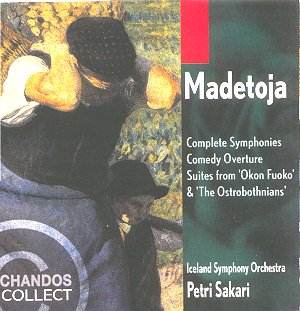MADETOJA
Symphonies complete; Comedy Overture; Suites from Okon Fuoko and The
Ostrobothnians.
 Iceland Symphony
Orchestra/Sakari
Iceland Symphony
Orchestra/Sakari
 Chandos CHAN 6626(2)
[66.55+71.25]
Midprice
Chandos CHAN 6626(2)
[66.55+71.25]
Midprice
Crotchet
Amazon UK
Amazon
USA

A truism, often overlooked, is the inescapable link between originality and
familiarity. The arrival of this Finnish music was serendipitous, just back
from Helsinki after covering the
Avanti
Summer Sounds festival for Seen&Heard.
Leevi Madetoja (1887-1947) has a head start in my book because I am
hearing his music for the first time (though I knew the name) and I rapidly
regretted that this had been so for half a century after his lifetime. As
a boy he played the kantele (a Finnish zither) and later studied at
Helsinki, quickly becoming highly regarded by his teacher Sibelius, who predicted
success as a symphonist. Kajanus (who had recently given Sibelius's new
5th - and whose first recording of it was a landmark in my boyhood
introduction to early 20th C music) championed Madetoja's music,
which was generally well received in Scandinavia.
I approached this double-CD by stealth, as it were, listening to the smaller
pieces first. Comedy Overture (1923) is fresh and well crafted,
restrained, well-orchestrated and a pleasure on first acquaintance. With
three good tunes, worked in rondo form, I suspect it would get any concert,
or a Prom, off to a good start. The suite from his successful nationalistic
opera (1923) begins with a long-held high tonic pedal, illustrating the vast
plains of Oborthnia, where Madetoja spent his childhood. There is a Prisoner's
Song and several folk-type tunes. The other suite, the first of three projected
from a failed ballet, is bolder, with rhythmic interest and pentatonic
('Japanese') harmony, and perhaps more of its music should be rescued.
The third symphony (1926) is reticent and ends quietly, eschewing dramatic
gesture, bring to mind once Sibelius's cool No. 6. I liked it a lot. Subtle
orchestration and memorable melodies make it very endearing; another work
that might be broadcast regularly if it were British and even risked in concert,
but for the marketing double-bind that the composer's name being unknown,
regular symphony concert-goers, who would find it a pleasing novelty, easy
to relate to even at first hearing, would not buy tickets. That is where
CDs come in to square the circle.
No. 1 (premiered under the composer's baton in 1916) is concise (23 mins)
and 'one of the most mature of first symphonies' (Erkki Salmenhaara). There
are distant echoes of Strauss & of Sibelius No.3 and it holds the attention
easily.. The tonal relationships are surprising; notionally in F, it finishes
in A. No. 2 in Eb, composed soon afterwards, commemorates his brother and
a friend killed during Finland's civil war. It is on a larger scale, with
the slow movement following attacca after an unresolved dissonant
chord ends the first. It ends resignedly in a modal E minor.
Well recorded and played in 1992 with conviction and apparent authority by
the Icelanders under Petri Sakari, this is a thoroughly worth while release
in the Chandos COLLECT Series.
Peter Grahame Woolf

